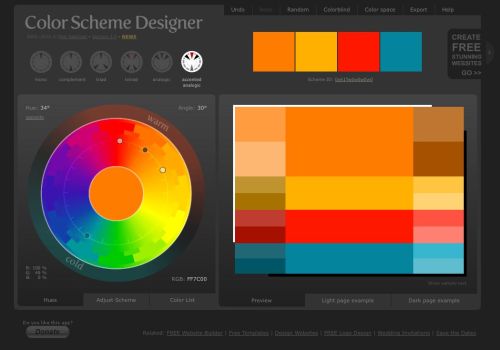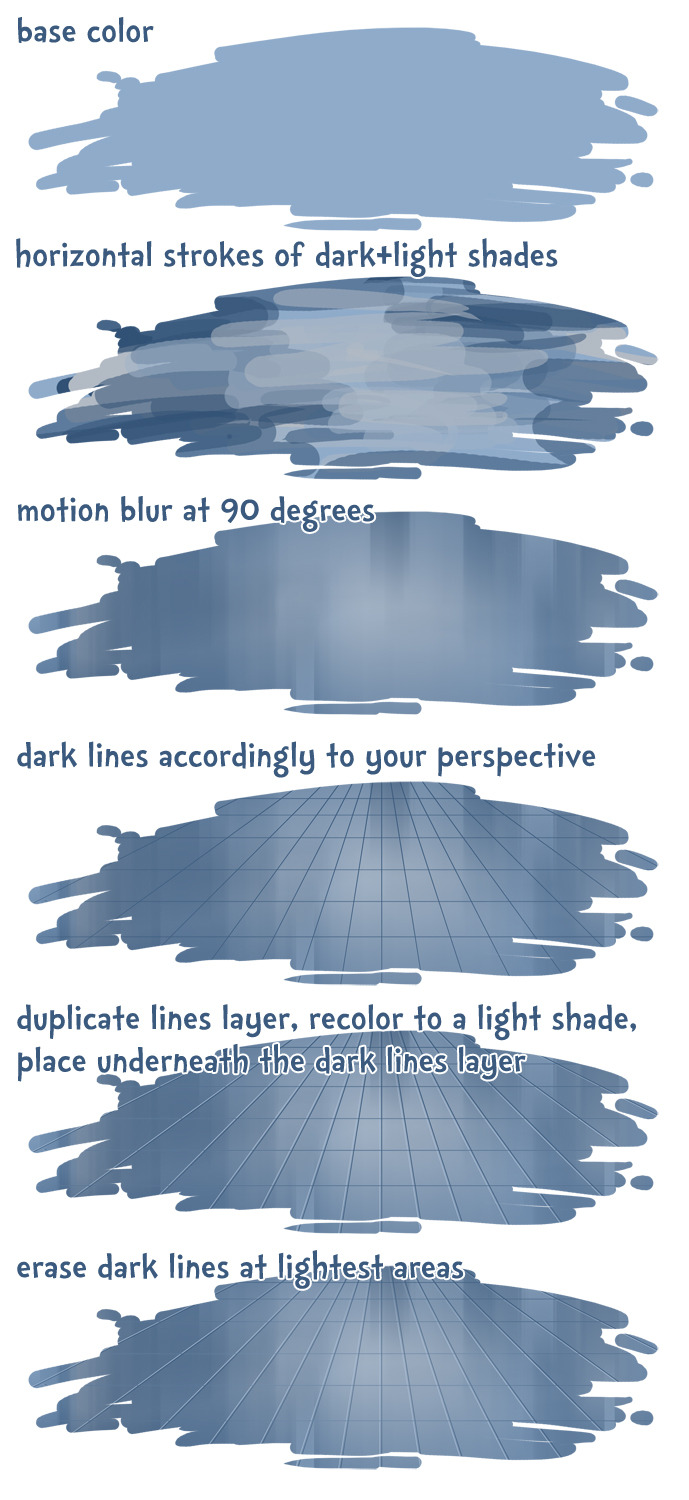Art Tutorial - Tumblr Posts
I forgot I have to be active here so here’s my Twitter tutorial on how to draw folds I made a while back to help a friend!
















A guide to designing wheelchair using characters!
I hope this helps anyone who's trying to design their oc using a wheelchair, it's not a complete guide but I tried my best! deffo do more research if you're writing them as a character
¡WARNING!: VERY long post ahead!

I was recently asked to do a tutorial for two friends, and I figured I’d share it here! It’s on how I personally use markers and colored pencils for portraits, so if that’s something you’re interested in then this is for you!
I must preface by saying this is my first tutorial/guide thingy and I’m no professional, but hopefully it helps some! This is only one way of going about it, don’t worry if it’s not your way!
Without further ado, let’s do this! And remember: Trust the process!!!
First, the angelic (😏) reference:

Now, we all see tones differently. I also am using the Art Alternatives Portrait Set, which is limited in tones. So, this won’t be completely picture accurate- which is okay! Essence over accuracy!
Alright! Here we go!
Step One: the sketch!

Typically I do the sketch in the person’s undertone, usually pinks or purples. However, for whatever reason I was compelled to try blue on this one, and hey- what is art if not random attempts at creating beauty?
And just like the color scheme, the sketch isn’t 100% accurate. But again, it’s all good!
But anyways, the reason I do my sketches in colored pencil is because it doesn’t smudge like graphite does, and it actually blends into the marker. I feel it’s smoother, and it provides some undertones as you start layering with marker.
Step Two: base tones

This is where you wonder if you just destroyed the entire drawing. I promise you that you didn’t! Basically what I do here is I put pinks down wherever I see pinks in the reference and lay down where the skin is the darkest. I find that it blends better when it’s underneath the base layer.
Step Three: the base layer

Here, all you do is throw down the skintone over the entirety of where it goes, in this case the face. I typically try to leave out highlights, but sometimes the marker bleeds and covers things I didn’t ask it to. In this case, that was the eyes. Oh well!
One thing to notice here is how you can still see the colored pencil beneath the sketch. That’s a very useful guide for when you begin detailing.
Step 3.5: uh

This isn’t necessarily a marker step, it’s just me letting the ink dry and working on other spots with pen and colored pencil. Also, I do like to go over the pink areas a few times to make them less stark.
Step Four: beginning detailing

Now, black is a tricky color on the face, because it can either smudge on everything and turn it gray, or work really well. I used a colored pencil here, and began going over the blue colored pencil spots and lines that were visible under the marked, which started to bring out his face. I also covered the highlight on the nose that had been left alone thus far.
Step Five: THE™️ details

If there’s anything I’ve learned in my five years of drawing, it’s that the highlights and darkest points are what really make the piece. Pure white, bright highlights (like the ones in the eyes) are awesome, but lately I like smudging them out a little bit so that they’re gentler.
If there’s anything you want to hit, it’s the whites of the eyes with the white gel pen, and the pupils + nostrils with the black fineliner.
I have shaky hands, but I use them to my advantage in stippling the darkest part of the eyebrows and in the line of the lips with the fineliner- it just adds a little bit more depth :)
Hair is its own thing, I just sort of wing it. Black hair especially is not the easiest for me, just because I find it difficult to bring out the shades in it. It’s not done at this step as I was trying to figure out how I was going to finish it.
I will also blend things out with both the skintone marker and a pink colored pencil just to get stuff to be smoother. If you’re going for semi realism/realism like me, I highly recommend taking a reddish brown to do some freckles/skin texture with. You can’t see it too much in this picture, and I didn’t want to overdo it since Cas/Misha doesn’t have that many freckles as far as I can see, but it does make a difference.
Step Six: everything else

I did the jacket in colored pencil as well as the fake id!
If you have any questions let me know, I’m happy to help!
Hope this is a decent guide :)



A Quick Blinking Animation Tutorial by VileBile
(Click the source for the full tutorial!)

Excellent tutorial to drawing cubby body types
“Some chubby guide for y’all!”
Source: paggiart on twitter







More art tutorials by Disney artists Griz and Norm Lemay
Mello people!!
I took notice on how some folks don't know how to color non transparent bases around here
They end up somtimes having "rat holes" (which are small uncolored parts) or looking lineless/shadeless
Which there's nothing wrong with, especially the lineless and shadeless part, everyone has their own style they prefer!
But I bet some of you would like to have their base art look more solid and not have to finagle with it so much, so that it looks like how they want
But how can ya do that you ask?
Fear not!
For I have made a little tutorial on how to for Ibispaintx☆
Passing down the knowledge I got from DianaTHEchicken on Amino (and the tips I learned over the years on my own)
1. First, you import the base of your choosing!
I'll be using my HiveWing Medowhawk as my example

2. Now, you go and open up the layers, add one below your base, click on the bases layer, then press where it says "Normal"

3. This opens a menu on Blending Mode
4. Now pick the Multiply option

5. Go back down to your color layer below and presto, it colors without messing with the the lines or shading!

(The reason it is below the base is because on top makes it uh... come out like this lol)


"But Thumper!
What about when it gets outside the lines? Erasing it is SO annoying and tedious!"
6. Well, that's when we go look at the side (for phone users you'll be clicking the pen on the bottom) and click the "Magic Wand" icon

This brings up a tiny menu that says "Gap Recognition" and it is pre-selected on "Add", which you want, and moving lines around the canvas and base appear

Now that on its own lets you color behind the base without touching the color you put, or the base

10. But to color without anything going outside the lines, you click the boxes that have two arrows next to them

This is the first part!
Here is the second part of the tutorial☆
Alrighty, at the request of @moondrift-the-icenight , here is a third part to the tutorial, specifically going over how to make wings transparent!
I'll be using a HiveWing as the subject again, as it's their wings that are the most whack to work with
1. I recommend putting your wing color layer above your body color layer, as not only will it help you customize the wings more, it'll also let any of the body behind the wing show through!

2. Now, you actually have two methods you can do for their wing transparency:
The Pen Way is to take the pen of your choice, and lower the opacity of it by 50% or lower.
Now, you color all in the wings until it covers them up!

(How it will look coloring all over)

This method does have a couple downsides:
You cannot use the bucket tool to make it quicker, as it doesn't really take opacity into consideration.
There is an opacity setting for it, but it does not do anything other than be a bucket with a different name (my guess is that it's bugged, I'll experiment further to see how it all works)
But for now, this is what happens when you do bucket

You also have to color the wings in one go, or else the opacity will build up and make the color solid instead of transparent

(An example on how that looks, it is purple to better show it. It does make a cool effect, so I also suggest playing with it. Experimentation is the way of art!)
And making markings is more difficult, sometimes requiring another layer depending how complex they are, as you'll end up doing a LOT of erasing
(Here is two examples of markings. If you would like, you can also merge the pattern layer down, with the arrow pointing down to the double lines, once you are done, like I had down for Meadowhawk, but it is not needed)


Now, the second method is the Layer Way, where you color the wings with 100% pen opacity, but then lower the opacity of the layer itself


This one is much easier, as it lets you go ham on the wings without any worry of build up from your pen, or having to spend a while with it and can instead use the bucket
Rejoice!
The one downside to this method is that you can absolutely not have it all on one layer, as it's the layer that makes it's see through, so it will make the body colors desaturated and funky (unless you want a desaturated and funky character lol)

All and all, I'd recommend the Layer Way to beginners and such, as it is a lot less finicky than pen
Though I also recommend experimenting! See which way ya like more and such, cause there's no wrong way to do art☆
Oh, and as a little side note, the wings for the rest of the dragons (except NightWing because of their wing pattern) work perfectly fine with solid color wings or 50% opacity wings
And that concludes this tutorial! If any of you have questions, ask away! I will answer the best I can.
Have a good day/night where ya are, and take care🎉
A general cane guide for writers and artists (from a cane user, writer, and artist!)
Disclaimer: Though I have been using a cane for 6 years, I am not a doctor, nor am I by any means an expert. This guide is true to my experience, but there are as many ways to use a cane as there are cane users!
This guide will not include: White canes for blindness, crutches, walkers, or wheelchairs as I have no personal experience with these.
This is meant to be a general guide to get you started and avoid some common mishaps/misconceptions in your writing, but you absolutely should continue to do your own research outside of this guide!
This is NOT a medical resource!!! And never tell a real person you think they're using a cane wrong!
![[Image text] Arm bends a little. Cane height at hip joint. Many canes have adjustable height. Cane sits within the natural center of balance. Causes stress on: Triceps, upper back, wrist (pressure) fingers (grip). Helps with: Joints (lower back, hip, knee, ankle, foot), weakness, balance, pain.](https://64.media.tumblr.com/0c8731401f496885dc8d4309a7dbe7ee/f831b3159e1d7635-e7/s500x750/6e5fe00081a6ce3b64cbe1a648f0c967f9f601e9.jpg)
The biggest recurring problem I've seen is using the cane on the wrong side. The cane goes on the opposite side of the pain! If your character has even-sided pain or needs it for balance/weakness, then use the cane in the non-dominant hand to keep the dominant hand free. Some cane users also switch sides to give their arm a rest!
A cane takes about 20% of your weight off the opposite leg. It should fit within your natural gait and become something of an extension of your body. If you need more weight off than 20%, then crutches, a walker, or a wheelchair is needed.
Putting more pressure on the cane, using it on the wrong side, or having it at the wrong height can make it less effective, and can cause long term damage to your body from improper pressure and posture. (Hugh Laurie genuinely hurt his body from years of using a cane wrong on House!)
(some people elect to use a cane wrong for their personal situation despite this, everyone is different!)
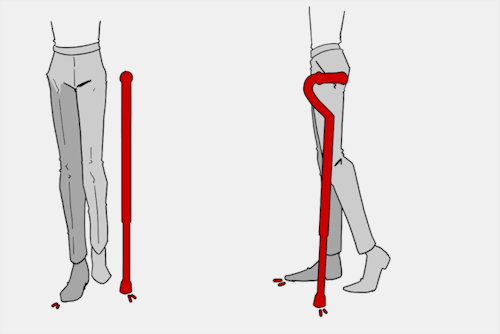
(an animated GIF of a cane matching the natural walking gait. It turns red when pressure is placed on it.)
When going up and down stairs, there is an ideal standard: You want to use the handrail and the cane at the same time, or prioritize the handrail if it's only on one side. When going up stairs you lead with your good leg and follow with the cane and hurt leg together. When going down stairs you lead with the cane and the bad leg and follow with the good leg!
Realistically though, many people don't move out of the way for cane users to access the railing, many stairs don't have railings, and many are wet, rusty, or generally not ideal to grip.
In these cases, if you have a friend nearby, holding on to them is a good idea. Or, take it one step at a time carefully if you're alone.
Now we come to a very common mistake I see... Using fashion canes for medical use!
![[Image text] 4 Major Handle Shapes (significant variation and uses). Tourist/Crook/Hook. Classic shape, fashion and medical, easy to hook on things (arm, door, chair, etc), generally solid wood (stronger, heavier). Offset. Newer design, not a fashion handle, only handle for quad-bases, generally better balance, usually aluminum (light + cheap), soft handle, adjustable (rattles/clicks when swinging). Derby/Fritz/Anatomical/Contour. Classic medical shape, many fashion variants, some fashion + medical, varies in many ways, sometimes contoured to hand, comes in foldable styles, many aluminum styles, many customizable styles. Knob/Decorative. Fashion exclusive, knob shape hurts the hand after prolonged pressure (especially with designs), tend to be heavy, "sword canes" have the same issues.](https://64.media.tumblr.com/102d2e5f13a88817eaa44974bc5a7486/f831b3159e1d7635-e2/s500x750/887023dbcfc758db12a7fcf3f258bca52eba2d53.jpg)
(These are 4 broad shapes, but there is INCREDIBLE variation in cane handles. Research heavily what will be best for your character's specific needs!)
The handle is the contact point for all the weight you're putting on your cane, and that pressure is being put onto your hand, wrist, and shoulder. So the shape is very important for long term use!
Knob handles (and very decorative handles) are not used for medical use for this reason. It adds extra stress to the body and can damage your hand to put constant pressure onto these painful shapes.
The weight of a cane is also incredibly important, as a heavier cane will cause wear on your body much faster. When you're using it all day, it gets heavy fast! If your character struggles with weakness, then they won't want a heavy cane if they can help it!
This is also part of why sword canes aren't usually very viable for medical use (along with them usually being knob handles) is that swords are extra weight!
However, a small knife or perhaps a retractable blade hidden within the base might be viable even for weak characters.
![[Image text] 4 Major base shapes (significant variation and uses). Adjustable base. Aluminum, standard modern medical, adjustable height, rubber base, wears down over time. Tripod/ quad base. If you need extra balance. Terrain attachment (varies, this is for ice). Removable, helps stop slipping on ice/snow/sand/etc, some canes have a retractable tip for ice. Classic base. Non-adjustable, custom only, modern standard still has a rubber base.](https://64.media.tumblr.com/78d350cfac4077376b7ce521a9a7d929/f831b3159e1d7635-ab/s500x750/4b4a6b8062c06686baf17c83c28b793bfb89e05b.jpg)
Bases have a lot of variability as well, and the modern standard is generally adjustable bases. Adjustable canes are very handy if your character regularly changes shoe height, for instance (gotta keep the height at your hip!)
Canes help on most terrain with their standard base and structure. But for some terrain, you might want a different base, or to forego the cane entirely! This article covers it pretty well.
Many cane users decorate their canes! Stickers are incredibly common, and painting canes is relatively common as well! You'll also see people replacing the standard wrist strap with a personalized one, or even adding a small charm to the ring the strap connects to. (nothing too large, or it gets annoying as the cane is swinging around everywhere)
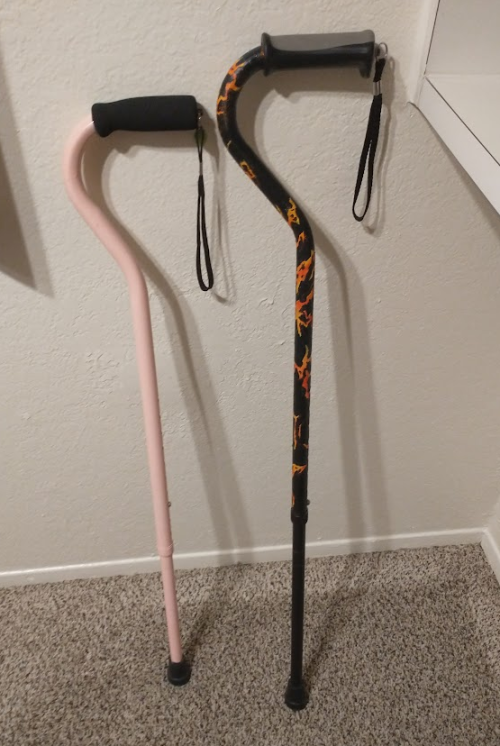
(my canes, for reference)
If your character uses a cane full time, then they might also have multiple canes that look different aesthetically to match their outfits!
When it comes to practical things outside of the cane, you reasonably only have one hand available while it's being used. Many people will hook their cane onto their arm or let it dangle on the strap (if they have one) while using their cane arm, but it's often significantly less convenient than 2 hands. But, if you need 2 hands, then it's either setting the cane down or letting it hang!
For this reason, optimizing one handed use is ideal! Keeping bags/items on the side of your free hand helps keep your items accessible.
![[Image text] Where to put your stuff. Purses/bags. A lot of size range, Can mess with balance, Zippers are too hard with one hand, Handheld means you have no hands, over the shoulder only. Fanny pack. Accessible with one hand, Limited space, Good for balance. Backpack. Very physically comfortable, evenly weighted, holds a lot (medicine, foldable cane, emergency supplies, etc) can't access without fully stopping and putting cane down/hooking it on arm/dangling on strap. Pockets. Can only use on free side, many outfits don't have good pockets.](https://64.media.tumblr.com/de0f85e864c0ac470fb08900d78d8375/f831b3159e1d7635-21/s500x750/dbc646d95d144bb9c097f220361f074cc4b59584.jpg)
When sitting, the cane either leans against a wall or table, goes under the chair, or hooks onto the back of the chair. (It often falls when hanging off of a chair, in my experience)
When getting up, the user will either use their cane to help them balance/support as they stand, or get up and then grab their cane. This depends on what it's being used for (balance vs pain when walking, for instance!)
That's everything I can think of for now. Thank you for reading my long-but-absolutely-not-comprehensive list of things to keep in mind when writing or drawing a cane user!
Happy disability pride month! Go forth and make more characters use canes!!!

Here's my guide to how I draw fat masc bodies! (please keep in mind that this is not an in depth tutorial. I only put the information that explains how my brain interprets it)
Looking for Something? (Mobile)
Anatomy:
Arms
Breasts
Body Types
Feet
Female
Hands
Heads -Ears -Expressions -Eyes -Facial -Hair -Mouths and Lips -Noses -Tears
Humans
Legs
Male
Muscles
Pelvis
Proportions
Shoulders
Torso
Animals:
Anatomy
Antlers
Beaks
Behaviour
Ears
Facial
Feathers
Fur
Hooves
Horns
Insects
Legs
Paws
Talons
Teeth
Wings
Backgrounds:
Cityscape
Indoors
Organic
Perspective
Quick BGs
Simplistic
Brushes:
Photoshop
Paint tool SAI
Design:
Buildings
Character Design
Clothing
Environments
Folds
Heights
Maps
Names
Sketching
Skin Tones
Drawing and Colouring:
Canvas Size
Colour Palettes
Colour Theory
Comics
Composition
Lighting
Lineart
Painting
Quick Tricks
Shading
Traditional
Fantasy:
Armor
Archery
Horns
Mythical Animals
Mythology
Power Ups
Weapons
Wings
For the Artist:
Copyright
File Types
Exercises
Portfolio
Reminders
Tablets
Tips and Advice
Tools
Languages:
ASL
Ancient
French
German
Grammar
Italian
Japanese
Korean
Morse
Spanish
Misc:
Animation
Commissions
Cosplay
Crafts
Life
Master Lists
Psychological
Resources
School
Writing
Nature:
Blood
Clouds
Fire
Flowers
Grass
Landscapes
Lightning
Metal
Plants
Rocks
Space
Trees
Water
Wood
Poses:
Angles
Animals
Draw Your X
Humans
Movement
Multiple Persons
Programs:
Clip Studio Paint
Krita
Paint Tool SAI
Photoshop
Etc
World Building:
Buildings
Culture
History
Historical Clothing
Video
Links
Schau dir "How to draw Kenma Kozume from Haikyuu!!" auf YouTube an
Me drawing kenma
I CANT- BrOoo!!HOw dO YoU drAw a hAlOoooo??!!! AND NOW DO YOU MAKE IT GLOOWWWOWOOW?!?!🔥🔥

edit i misread cuz im dumb and sleep deprived just draw a circle and follow the light part
first, you need to know where your hair is coming from in the first place. i like to divide it in lenght so here we have bangs (pink outline), side hair (green outline) and back hair (blue outline).
in most front facing works the attention will be on the face so our priority is bangs, side hair then back hair. you can divide all of them into smaller subsections too but its most commonly done with the bangs, such as how i showed with the different bisexual colors.
think of hair flowing like the wind, despite there being imperfections, overlaps, strong and weak areas it all follows a general flow.
know what your hair is like in 3d and see how strands would overlap and interact like strangely shaped ribbons, which you can mostly do just by feel but still follow the wind rule
feel free to twist and turn them like ribbons too
for longer hair, strands might pop out just to loop back in as shown on her back hair (shes wearing loose twintails), those most often show ribbon-like behavior
make sure their thickness doesnt decrease too abruptly and that the lenght of the stray hairs is the same as the section they come from
now light:

know where your light source is coming from, here its useful to think in 3D instead of just picking a side of the canvas. Here, the light source is above and slightly in front of the character.
Those ball-shading exercises your art teachers made you do will come in handy here, so map out how light would fall on your characters mostly round head
now just think about which strands stick out enough to catch more light than the others, and carve shadows into sections that wouldnt catch light like that

you also just follow the general flow here, its all about that flow
pro tip: use a low opacity big size airbrush to erase the lower part of the bangs that cover ur characters face to make them ~glow~
and remember, dont be shy with the aggressiveness of your lighting


wanted to add little bonus note that the thing i like most w this method is that they’re such simple shapes u don’t even have to draw them entirely. after a while it gets pretty easy 2 just infer and imagine the rest of the lines!!
makes for very quick but efficient sketching ^_^



my recipe for drawing hands!
(small note that this is a shortcut that is more abt style and ease than anatomical accuracy. it helps to take time to really properly study hands, makes it easier to bend the rules a bit like this and have it still look good!!)
(learn rules b4 u break them or whatevah)
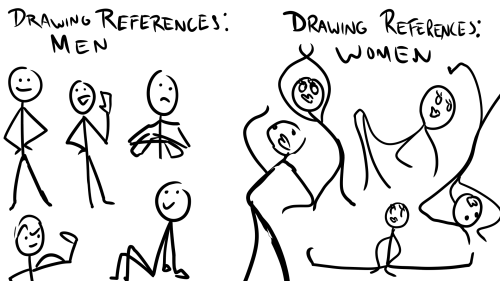
i know we joke about cis artists having the weirdest sense of anatomy, but also even when the anatomy is fine, no one seems to want to draw women doing normal things

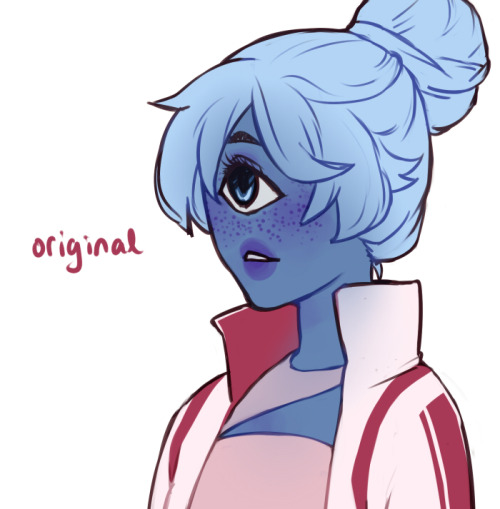
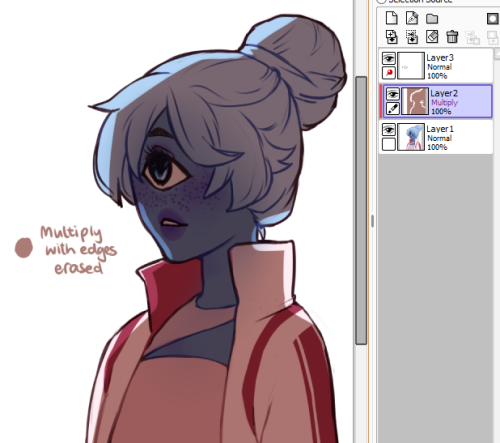
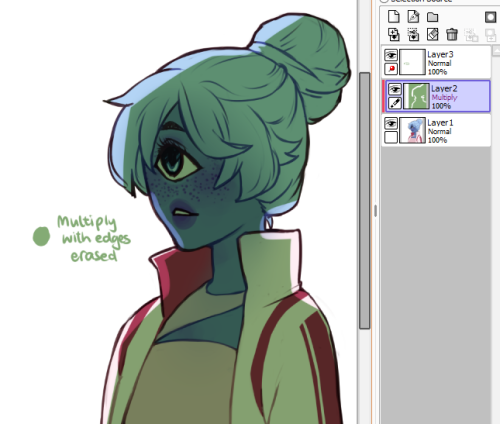
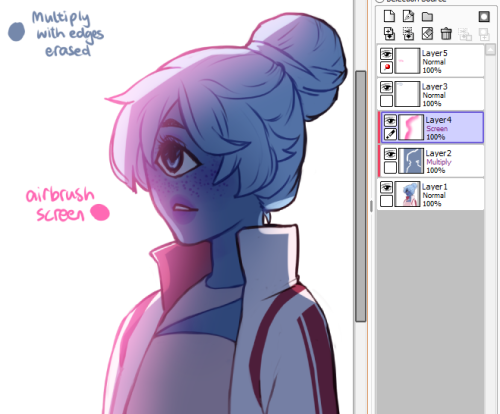
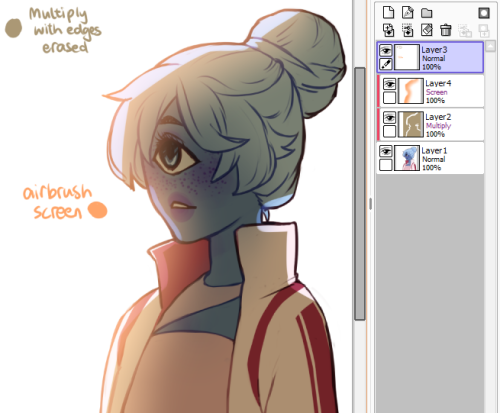
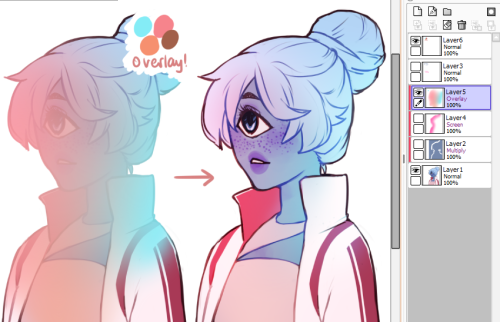
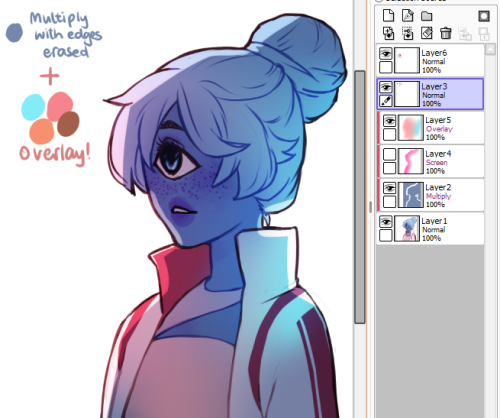
uuu thank u anon!! i hope this can explain it :^o
i use overlay all the time to make colours more vibrant and to make areas warmer or cooler. good for colourful ambient light (like glowy magic stuff).
multiply is really good for establishing a light source very quickly!! play around with the hue to get shadows with cool colours. for more detailed work you can use two or three tones on a multiply layer for more dimension.
screen is something i only recently started using regularly! it’s really great if you have a very bright light source. you can also use screen and paint on the edges of a backlit character to make the lighting more intense. a good thing to know about screen layers is that the darker the colour you use, the less it lightens; using black on a screen layer leaves no effect on the colours underneath (the opposite is true for multiply layers!).
and you can also use these layers for an entire painting instead of just on a character! i don’t have a visual example on hand, but stuff like making the area around a warm light source warmer, making a light source brighter and more vibrant, or using gradients set on multiply or screen are just some of the ways you can apply these to a full painting :)
Tucking this under my pillow.







HII my character & shape design tips PDF is now available! ^_^ hope you enjoy !!
BUY HERE or HERE








Download this free brushset here!
Contributions greatly appreciated but not necessary! Can’t wait to see what everyone creates with these. Please open the “README” txt document first for full install instructions and a link to the video downloads.
